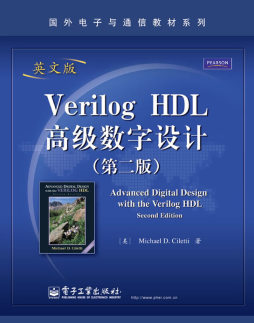Verilog HDL高级数字设计
出版社:电子工业出版社
年代:2010
定价:99.0
书籍简介:
本书依据数字集成电路系统工程开发的要求与特点,以ASIC/FPGA系统芯片工程开发流程及工程设计为主线写成,内容包括EDA技术,集成电路芯片的前后端设计、验证、实现与测试,集成电路的工程开发经验与设计案例分析等。书中以大量设计实例叙述了集成电路系统工程开发应遵循的原则、基本方法、实用技术、经验技巧等,极具工程设计特色与技术风格。
作者介绍:
书籍目录:
1 Introduction to Digital Design Methodology
1.1 Design Methodology-An Introduction
1.1.1 Design Specification
1.1.2 Design Partition
1.1.3 Design Entry
1.1.4 Simulation and Functional Verification
1.1.5 Design Integration and Verification
1.1.6 Presynthesis Sign-Off
1.1.7 Gate-Level Synthesis and Technology Mapping
1.1.8 Postsynthesis Design Validation
1.1.9 Postsynthesis Timing Verification
1.1.10 Test Generation and Fault Simulation
1.1.11 Placement and Routing
1.1.12 Physical and Electrical Design Rule Checks
1.1.13 Parasitic Extraction
1.1.14 Design Sign-Off
1.2 IC Technology Options
1.3 Overview
References
2 Review of Combinational Logic Design
2.1 Combinational Logic and Boolean Algebra
2.1.1 ASIC Library Cells
2.1.2 Boolean Algebra
2.1.3 DeMorgan s Laws
2.2 Theorems for Boolean Algebraic Minimization
2.3 Representation of Combinational Logic
2.3.1 Sum-of-Products Representation
2.3.2 Product-of-Sums Representation
2.4 Simplification of Boolean Expressions
2.4.1 Simplification with Exclusive-Or
2.4.2 Karnaugh Maps (SOP Form)
2.4.3 Karnaugh Maps (POS Form)
2.4.4 Karnaugh Maps and Don t-Cares
2.4.5 Extended Karnaugh Maps
2.5 Glitches and Hazards
2.5.1 Elimination of Static Hazards (SOP Form)
2.5.2 Summary: Elimination of Static Hazards in Two-Level Circuits
2.5.3 Static Hazards in Multilevel Circuits
2.5.4 Summary: Elimination of Static Hazards in Multilevel Circuits
2.5.5 Dynamic Hazards
2.6 Building Blocks for Logic Design
2.6.1 NAND-NOR Structures
2.6.2 Multiplexers
2.6.3 Demultiplexers
2.6.4 Encoders
2.6.5 Priority Encoder
2.6.6 Decoder
2.6.7 Priority Decoder
References
Problems
3 Fundamentals of Sequential Logic Design
3.1 Storage Elements
3.1.1 Latches
3.1.2 Transparent Latches
3.2 Flip-Flops
3.2.1 D-Type Flip-Flop
3.2.2 Master-Slave Flip-Flop
3.2.3 J-K Flip-Flops
3.2.4 T Flip-Flop
3.3 Busses and Three-State Devices
3.4 Design of Sequential Machines
3.5 State-Transition Graphs
3.6 Design Example: BCD to Excess-3 Code Converter
3.7 Serial-Line Code Converter for Data Transmission
3.7.1 Design Example: A Mealy-Type FSM for Serial Line-Code Conversion
3.7.2 Design Example: A Moore-Type FSM for Serial Line-Code Conversion
3.8 State Reduction and Equivalent States
References
Problems
4 Introduction to Logic Design with Verilog
4.1 Structural Models of Combinational Logic
4.1.1 Verilog Primitives and Design Encapsulation
4.1.2 Verilog Structural Models
4.1.3 Module Ports
4.1.4 Some Language Rules
4.1.5 Top-Down Design and Nested Modules
4.1.6 Design Hierarchy and Source-Code Organization
4.1.7 Vectors in Verilog
4.1.8 Structural Connectivity
4.2 Logic System, Design Verification, and Test Methodology
4.2.1 Four-Value Logic and Signal Resolution in Verilog
4.2.2 Test Methodology
4.2.3 Signal Generators for Testbenches
4.2.4 Event-Driven Simulation
4.2.5 Testbench Template
4.2.6 Sized Numbers
4.3 Propagation Delay
4.3.1 Inertial Delay
4.3.2 Transport Delay
4.4 Truth Table Models of Combinational and Sequential Logic with Verilog
References
Problems
5 Logic Design with Behavioral Models of Combinational and Sequential Logic
5.1 Behavioral Modeling
5.2 A Brief Look at Data Types for Behavioral Modeling
5.3 Boolean Equation-Based Behavioral Models of Combinational Logic
5.4 Propagation Delay and Continuous Assignments
5.5 Latches and Level-Sensitive Circuits in Verilog
5.6 Cyclic Behavioral Models of Flip-Flops and Latches
5.7 Cyclic Behavior and Edge Detection
5.8 A Comparison of Styles for Behavioral Modeling
5.8.1 Continuous Assignment Models
5.8.2 Dataflow/RTL Models
5.8.3 Algorithm-Based Models
5.8.4 Naming Conventions: A Matter of Style
5.8.5 Simulation with Behavioral Models
5.9 Behavioral Models of Multiplexers, Encoders, and Decoders
5.10 Dataflow Models of a Linear-Feedback Shift Register
5.11 Modeling Digital Machines with Repetitive Algorithms
5.11.1 Intellectual Property Reuse and Parameterized Models
5.11.2 Clock Generators
5.12 Machines with Multicycle Operations
5.13 Design Documentation with Functions and Tasks: Legacy or Lunacy?
5.13.1 Tasks
5.13.2 Functions
5.14 Algorithmic State Machine Charts for Behavioral Modeling
5.15 ASMD Charts
5.16 Behavioral Models of Counters, Shift Registers, and Register Files
5.16.1 Counters
5.16.2 Shift Registers
5.16.3 Register Files and Arrays of Registers (Memories)
5.17 Switch Debounce, Metastability, and Synchronizers for Asynchronous Signals
5.18 Design Example: Keypad Scanner and Encoder
References
Problems
6 Synthesis of Combinational and Sequential Logic
6.1 Introduction to Synthesis
6.1.1 Logic Synthesis
6.1.2 RTL Synthesis
6.1.3 High-Level Synthesis
6.2 Synthesis of Combinational Logic
6.2.1 Synthesis of Priority Structures
6.2.2 Exploiting Logical Don t-Care Conditions
6.2.3 ASIC Cells and Resource Sharing
6.3 Synthesis of Sequential Logic with Latches
6.3.1 Accidental Synthesis of Latches
6.3.2 Intentional Synthesis of Latches
6.4 Synthesis of Three-State Devices and Bus Interfaces
6.5 Synthesis of Sequential Logic with Flip-Flops
6.6 Synthesis of Explicit State Machines
6.6.1 Synthesis of a BCD-to-Excess-3 Code Converter
6.6.2 Design Example: Synthesis of a Mealy-Type NRZ-to-Manchester Line Code Converter
6.6.3 Design Example: Synthesis of a Moore-Type NRZ-to-Manchester Line Code Converter
6.6.4 Design Example: Synthesis of a Sequence Recognizer
6.7 Registered Logic
6.8 State Encoding
……
7 Design and Synthesis of Datapath Controllers
8 Programmable Logic and Storage Devices
9 Algorithms and Architectures for Digital Processors
10 Architectures for Arithmetic Processors
11 Postsynthesis Design Tasks
A Verilog Primitives
B Verilog Keywords
C Verilog Data Types
D Verilog Operators
E Verilog Language Formal Syntax
F Verilog Language Formal Syntax
G Additional Features of Verilog
H Flip-Flop and Latch Types
I Verilog-2001, 2005
J Programming Language Interface
K Web sites
L Web-Based Resources
Index
内容摘要:
《Verilog HDL高级数字设计(第2版)(英文版)》依据数字集成电路系统工程开发的要求与特点,利用Verilog HDL对数字系统进行建模、设计与验证,对ASIC/FPGA系统芯片工程设计开发的关键技术与流程进行了深入讲解,内容包括:集成电路芯片系统的建模、电路结构权衡、流水、多核微处理器、功能验证、时序分析、测试平台、故障模拟、可测性设计、逻辑综合、后综合验证等集成电路系统的前后端工程设计与实现中的关键技术及设计案例。书中以大量设计实例叙述了集成电路系统工程开发需遵循的原则、基本方法、实用技术、设计经验与技巧。
《Verilog HDL高级数字设计(第2版)(英文版)》既可作为电子与通信、电子科学与技术、自动控制、计算机等专业领域的高年级本科生和研究生的教材或参考资格,也可用于电子系统设计及数字集成电路设计工程师的专业技术培训。
编辑推荐:
《Verilog HDL高级数字设计(第2版)(英文版)》特色
·重点讨论现代数字电路系统的设计方法
·阐述并推广基于Verilog 2001和2005,且可综合的RTL描述和算法建模的设计风格
·明确指出了可综合和不可综合循环的区别
·讲述了如何应用ASM和ASMD图进行行为级建模
·深入讨论基于Verilog 2001和2005的数字处理系统、RISC计算机和各种数据通道控制器、异步和同步FIFO设计的算法和架构及综合的设计实例
·给出了150多个经过完全验证的实例,对时序分析、故障模拟、测试和可测性设计进行切合实际的讨论
·含有利用Vetilog 2001和2005编写的具备JTAG和BIST可测功能的实用设计案例
·每章后均设计了一些涉及面广且难度高的习题
·包含一套与《Verilog HDL高级数字设计(第2版)(英文版)》内容配套的可适合实验室实验验证的FPGA设计实例,如ALU、可编程电子锁、有FPFO的键盘扫描器、可纠错的串行通信接口、基于SRAM的控制器、异步和同步FIFO设计、存储器及RISC CPU
《Verilog HDL高级数字设计(第2版)(英文版)》支持网站内容包括:所有模型的源文件、仿真实例的测试平台源文件、幻灯片文件、某些工具软件的速
成教案及常见问题解答(FAQ)
书籍规格:
| 书籍详细信息 | |||
| 书名 | Verilog HDL高级数字设计站内查询相似图书 | ||
| 丛书名 | 国外电子与通信教材系列 | ||
| 9787121104770 如需购买下载《Verilog HDL高级数字设计》pdf扫描版电子书或查询更多相关信息,请直接复制isbn,搜索即可全网搜索该ISBN | |||
| 出版地 | 北京 | 出版单位 | 电子工业出版社 |
| 版次 | 1版 | 印次 | 1 |
| 定价(元) | 99.0 | 语种 | 英文 |
| 尺寸 | 26 × 0 | 装帧 | 平装 |
| 页数 | 印数 | 5000 | |
书籍信息归属:
Verilog HDL高级数字设计是电子工业出版社于2010.4出版的中图分类号为 TP312 的主题关于 硬件描述语言,Verilog HDL-程序设计-教材-英文 的书籍。
- Verilog HDL高级数字设计2004.02
(美) 西里提 (Ciletti,M.D.) , 著
- Verilog HDL高级数字设计2004.12
(美) 西里提 (Ciletti,M.D.) 等, 著
- Verilog HDL数字系统设计2011.2
王建民, 田晓华, 江晓林, 编著
- Verilog HDL数字设计教程2010.4
贺敬凯, 编著
- Verilog HDL数字设计与综合2009.07
(美) 帕尔尼卡 (Palnitkar,S.) , 著
- Verilog HDL数字设计与综合2004.10
(美) 帕尔尼卡 (Palnitkar,S.) , 著
- 设计与验证——Verilog HDL2006.08
吴继华, 王诚, 编著
- 精通Verilog HDL2005.10
简弘伦, 编著
- Verilog HDL入门2008.08
(美) 巴斯克 (Bhasker,J.) , 著
